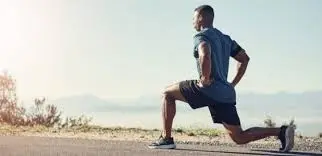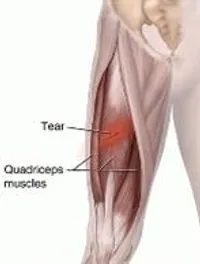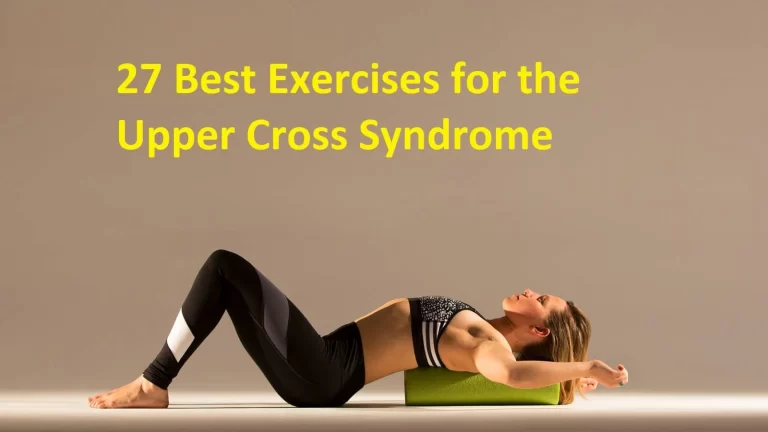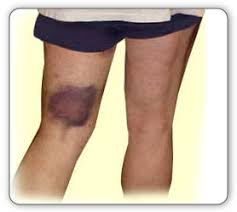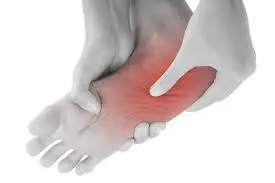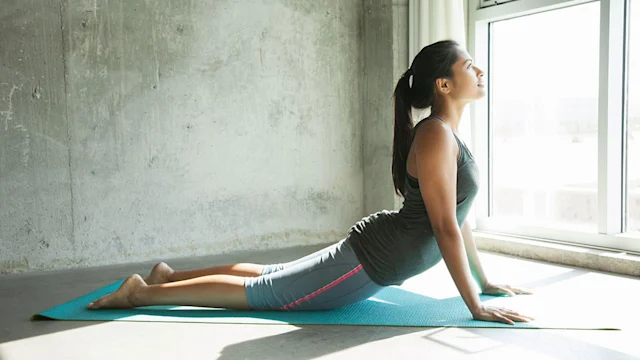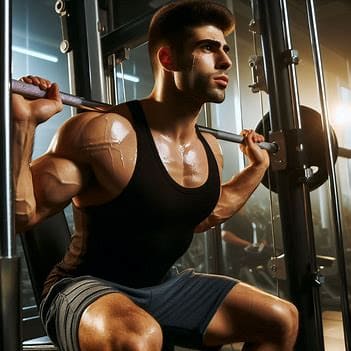52 Best Exercises for Knee Pain
Knee pain is one of the most common problems among people, affecting people of all ages. It can be caused by a variety of conditions or injuries, such as damage to the cartilage or a torn ligament near the knee.
More severe injuries may need physical therapy or knee braces, but mild cases of knee pain can be treated at home or with self-care. In a few cases, surgery can be necessary.
Once the pain reduces, you can begin doing mild workouts to maintain knee mobility and restore muscle strength. It is necessary to rest, but too much relaxation could prolong your healing.
Knee pain exercise and why you must practice it. This article’s goal is to provide information to you on the value and advantages of exercising for knee pain. Exercise for knee pain is important since it reduces pain and strengthens the muscles that surround the knee. You may strengthen your muscles and improve your ability to move about and perform daily duties by participating in a knee pain exercise.
Depending on the diagnosis and symptoms of the condition, physiotherapists are going to identify the cause, onset, aggravating, and relieving factors of your knee pain before recommending a course of treatment.
Introduction
Exercise for knee pain is especially important for those undergoing knee muscle rehabilitation. Exercises for knee pain can increase the strength and muscle mass in your knees. You can work out on your own at home to relieve knee pain.
Muscles become more flexible and strong with exercise. Physiotherapy provides light stretching and strengthening exercises that can help reduce pain in the knee, whether it comes from an injury, surgery, arthritis, or other conditions. These exercises also help to improve range of motion and flexibility (ROM).
The muscles surrounding your knee joint can be strengthened with easy at-home stretching and strengthening exercises. Reduced stress and strain on the knee as well as improved knee joint function may result from stronger knee muscles.
While regular exercise may seem good for improving the function of an injured or arthritic knee joint, it is not always advised to exercise when experiencing acute knee pain. Muscle and joint stiffness from immobilizing your knee may worsen pain and make it more difficult to carry out daily tasks.
Target Muscles: The following muscle groups are the focus of this conditioning protocol;
- Quadriceps (front of the thigh)
- Hamstrings (back of the thigh)
- Abductors (outer thigh)
- Adductors (inner thigh)
- Gluteus medius and gluteus maximus (buttocks)
Consult a physical therapist to make sure that the exercises recommended are right for your condition before beginning any exercise program for knee pain. Depending on your diagnosis, they might advise you to take some medication, take it easy for a week or two, and then resume your exercise routine.
Knee pain symptoms:
Depending on the root of the problem, The location of knee pain symptoms could change. (where it is felt) and degree (mild, moderate, and severe).
Knee pain symptoms and indications include;
- Weakness or instability.
- Popping or crunching noises.
- Inability to fully straighten the knee.
- Swelling and stiffness.
- Redness and warmth to the touch.
Causes of Knee Pain:
- Bursitis
- Meniscus tears
- Sprained knee ligaments
- Overuse
- Osteoarthritis
- Tendinitis
The following are some advantages of exercise for knee pain:
The following are some advantages of regular exercise.
- Increase your range of motion.
- Increase your level of flexibility.
- Weak muscles can be strengthened with the help of exercise.
- Release pressure.
- Release tight and stiff muscles
- Exercise can help with improving mobility.
- Improving coordination.
- Gain better balance.
- Improved physical health
- Improves the performance of everyday workout
- Improved muscle tone and relaxation
- Reduce your level of pain
How to figure out if the level of your exercise is right for you:
You can find out whether you’re exercising at the right level with the help of this guide. It will allow you to find out a suitable degree of pain or feeling uncomfortable.
It can be helpful to rate your pain on a scale of 0 to 10, where 10 is the worst pain you have ever felt. For example, this:
- 0 to 3 – Minimal pain
- 4 to 5 – Tolerable pain
- 6 to 10 – Severe pain
Pain when exercising:
Try to maintain a suffering scale of 0 to 5. In case your pain goes above this limit, you can modify the exercises by;
- Lowering the number of times you perform a movement
- Decreasing a movement’s speed
- Extending the rest period in between movements
Pain after exercise:
Your knee pain shouldn’t get worse after exercising. On the other hand, as the body adjusts to new movements, trying out new exercises can occasionally result in mild muscular pain. When you exercise in the morning, the pain you experience should go away quickly and not get any worse.
The best exercise for knee pain is:
The following exercises are helpful to many people. Make any required position adjustments for your comfort. Try to perform these workouts daily. Start by doing each one a few times to get familiar with it, then progressively increase the amount of times you do it.
Ankle pump exercise
- With your back straight against a chair, sit or lie down.
- legs have been extended and a little apart.
- The toes should point upwards to make the soles flat.
- As much as possible, direct your feet toward your knees.
- Then, try your best to direct them away from you.
- To complete the task, bend your feet in each direction in turn.
- For the short duration of a few seconds, hold your toes in this stretched position.
- Next, slowly bring your foot back to the point where it is straight to the floor.
- After that, relax.
- Repeat this exercise five or ten times.
- Repeat with the same exercise using the other leg.
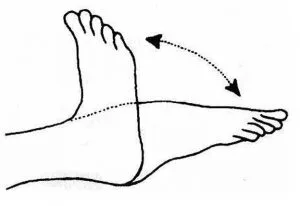
VMO Exercise: Terminal Knee Extensions
- First, you’ll need one medium-sized ball for this activity.
- Place the ball under your knee joint while lying supine on your back on the mat or plinth.
- Next, raise one heel off the ground gently until the knee joint is straight.
- After holding the knee straight for a few seconds, slowly lower your leg.
- After that, return to a neutral position.
- Next, relax.
- Repeat this exercise five or ten times.
- Repeat the exercise on the other leg.
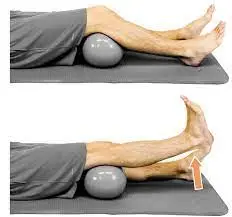
Heel and calf stretch
- Step back as far as is comfortable after placing your hands on the wall.
- Your knees should be slightly bent, your toes facing forward, and your heels flat.
- Pull into the stretch and hold it for a few moments.
- Your back leg should be feeling stretched.
- After that, return to a neutral position.
- Next, relax.
- Repeat this exercise five or ten times.
- Repeat the exercise on the other leg.
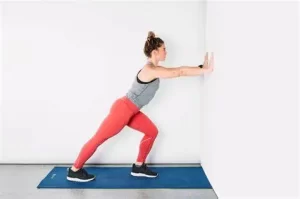
Half squat
- Keeping your feet shoulder-width apart when squatting.
- To maintain balance, place your hands on your hips or in front of you.
- Lean forward slightly and lower about ten inches at a time.
- In a full squat, this is the middle position.
- Hold this position for a few seconds.
- Then return to your neutral position.
- After that, relax.
- Repeat this exercise five or ten times.
- Use the other leg to complete the same exercise.
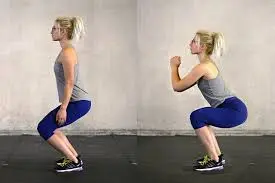
Calf raises
- Start with a relaxing standing position.
- For support, take a seat close to a wall or grasp the back of a chair.
- Raise both heels off the floor to position yourself on the heel of your feet.
- Maintain this position for a few seconds.
- Slightly lower your heels to the starting position.
- After that, relax.
- Repeat this exercise five or ten times.
- Control is necessary when doing this workout to strengthen your calf muscles.
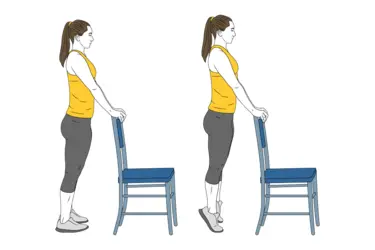
Hamstring curl
- Start with a relaxing standing position.
- You should have a hip-width gap between your feet.
- Raise your heel toward the sky, lift one foot, and extend your knee.
- Stretch as far as you can while keeping your legs pointed forward and your upper body straight.
- Hold this position for a few seconds.
- Move your heels to the starting position slowly.
- Then relax.
- Repeat this exercise five or ten times.
- Repeat with the other leg.
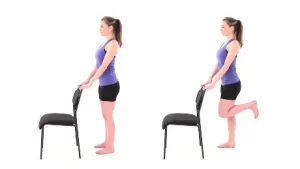
Leg extensions
- To begin with, sit upright in a long chair with your leg down or resting on a plinth.
- To increase your strength without getting your buttocks off the chair, look straight ahead, tighten your thigh muscles, and extend one leg as high as you can.
- Hold this position for a few seconds.
- After that, resume a neutral position.
- After that, relax.
- You should perform this workout five or ten times.
- On the other leg, perform the same exercise again.
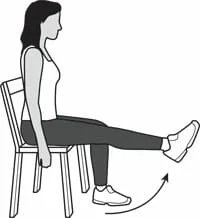
Prone hamstring curls
- Prone is the starting position.
- Lie down flat on your abdomen.
- As slowly as you can, pull the heels into your buttocks.
- Hold this position for a few seconds.
- Return to a neutral position after that.
- After that, relax.
- Perform this workout five or ten times.
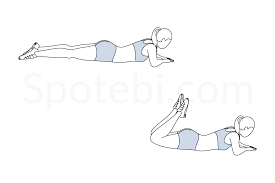
Wall Squats
- Standing close to the wall is the starting position.
- Maintain your feet on the ground.
- Place your back up against a wall.
- Make sure your feet are shoulder-width apart.
- Keep your back and pelvis against the wall while bending your knees slowly.
- Avoid going too far.
- Hold this position for a few seconds.
- Return to a neutral position after that.
- After that, relax.
- Perform this workout five or ten times.
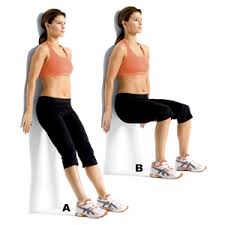
Step up
- Start with a relaxing standing position.
- Position one at the foot of a step bench, a platform, or the bottom step of a staircase.
- Maintain the height at the level of the pelvis.
- Bend at the knee and carefully drop to the floor with the opposing foot.
- Gently put your toe on the ground, then stand back up to take your place.
- Return to a neutral position after that.
- After that, relax.
- Perform this workout five or ten times.
- Work the other leg with the same exercise.
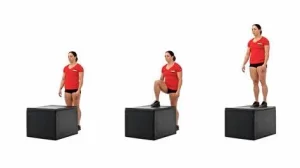
Standing knee flexion
- Start with a relaxing standing position.
- Bend the knee to a 90-degree angle while keeping the thigh straight relative to the upper body, then progressively lower it.
- Maintain the foot’s flexion during the entire motion.
- Make sure the thigh stays parallel to the trunk and keep it pressed up against a table.
- Keep this posture for a short amount of time.
- Then return to your neutral position.
- Then relax.
- Perform this workout ten or five times.
- Work the other leg with the same exercise.
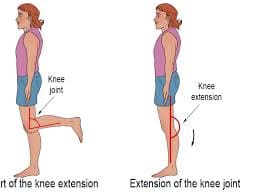
Extended Hand-to-Big-Toe Pose
- Start with a relaxing standing position.
- While standing, raise your right leg and bend it toward your chest.
- With your right hand, grasp your right big toe.
- Stretch slowly to the straight right leg and then out to the side.
- Hold this position for a short amount of time.
- Return to a neutral position after that.
- After that, relax.
- This exercise should be done five or 10 times.
- Perform the same movement to the other leg.
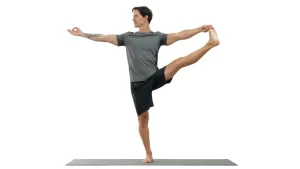
Seated Forward Bend at a Wide Angle
- Sitting is the starting position.
- Flex your feet and maintain your knees and toes pointing upward toward the ceiling.
- Apply force to your lower limbs and extend your back.
- Breathe gently in and out while placing your hands on the floor in front of your legs and starting to move them forward.
- Keep the length of your front body stable as you expand the bend.
- Just be careful that your back doesn’t start to arch.
- Hold this position for a few seconds.
- To get out of the pose, straighten your back, press your sitting bones into the ground, and release your breath.
- Return to a neutral position after that.
- After that, relax.
- This exercise should be done five or 10 times.
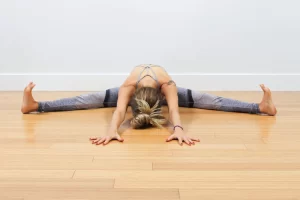
Side-Lying Quadricep Stretch
- Start with a relaxing side-lying position on the ground.
- Bend the knee of your upper leg as far as possible by lightly pulling with your hand.
- Hold this position for a few seconds.
- Return to a neutral position after that.
- After that, relax.
- You should complete this exercise five or ten times.
- Change your legs and repeat the exercise.
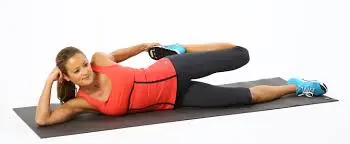
Hip Abduction
- As you lie on your side, raise your injured upper leg and bend your lower leg to support yourself.
- Maintaining a straight but not locked knee.
- Lying upright, slowly raise your upper leg to a 45° angle.
- For a few seconds, maintain this posture.
- After that, take a neutral position.
- After that, relax.
- You should complete this exercise five or ten times.
- Repeat the exercise with opposite legs.
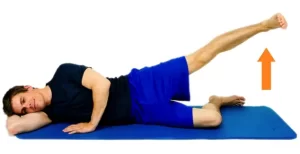
Leg Presses
- The ideal way to complete this exercise is with a comfortable resistance elastic stretch band.
- Hold the ends of the elastic band in each hand and position the center at the arch of your foot.
- As you lie on the floor, bend your elbows.
- You can raise your knee closer to your chest by pulling the thigh muscles of your affected leg tight.
- Bend your foot while applying pressure to the elastic band, then slowly raise your leg in front of you.
- Maintain this position for a few seconds.
- Take a neutral position after that.
- Be relaxed after that.
- This is an exercise you should do five or ten times.
- With the opposing legs, repeat the exercise.
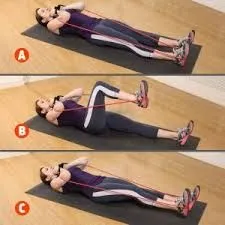
Hamstring Band Stretch
- Start with a relaxing supine position on the yoga mat.
- Lift one leg off the mat with the knee slightly bent.
- Put a resistance band on the outstretched leg’s heel.
- As near to your chest as feels comfortable, pull the leg in.
- Maintain this position for a few seconds.
- Take a neutral position after that.
- Next, relax.
- Continue with the other leg.
- Repeat these steps five to ten times.
Quadriceps exercises
- Placing your legs straight out in front of you while lying or sitting on your back with support for your back.
- Put a small rolled towel under your knee.
- Move one foot slightly to the side and pull the other in your direction.
- You will feel your thigh muscles contract as you press your knee down with force.
- Hold this position for a few seconds.
- Once that’s done, go back to your neutral position.
- After that, relax.
- Repeat this exercise 5–10 times a day.
- Do the same with the other leg.
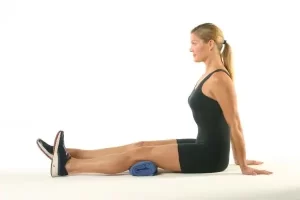
Seated forward bend (paschimottanasana)
- With your legs extended straight out in front of you on the ground in a long sitting position.
- With your toes flexed toward you, maintain an upright spine.
- Continue breathing normally.
- Stretch up and raise both arms above your head while deep breathing.
- Exhale slowly, bend forward from the hip joint, and try to maintain the bend in your spine as your neck moves toward your toes.
- Place both of your hands where your legs are extended, without straining.
- Maintain this posture for a short while.
- Once the breath is fully inhaled, raise your arms straight above your head.
- Exhale and take a step back to where you were before.
- Take a few moments to relax.
- Repeat this exercise 5–10 times a day.
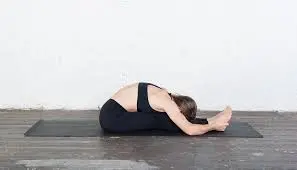
Clamshell
- To start, you lie on your side.
- Lying on your left side, bend your elbow.
- Next, use your left hand to hold the support up to your head.
- Make a 45-degree angle with your knees after placing your right foot and leg on top of your left.
- Put your right hand on your hip or gently on the ground in front of your body for balance.
- Next, with your feet close to your body, slowly raise your right knee toward the ceiling.
- Raise your lower right leg back up to meet your left while maintaining a tight core.
- Maintain this position for a short amount of time.
- Next, take a neutral position.
- After that, relax.
- On the other leg, continue the exercise.
- Perform this exercise five or ten times.
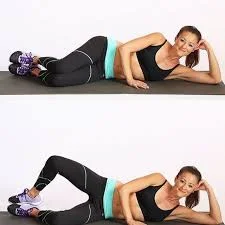
Single Knee to Chest
- Lie down on your back on a soft surface, like a yoga mat, blanket, or bed, to begin.
- Maintain a relaxed head and shoulders while holding this stretch.
- Pull your left knee slightly in the direction of your chest with both hands behind it.
- Hold on for a little while.
- Just keep your leg straight in front of you or slightly bend your knee.
- Next, take a neutral position.
- After that, relax.
- Release your grip and lift your right leg, being sure that you hold it with both hands slightly behind the knee.
- Keep your right knee pulled under your chest for a short while.
- Repeat steps 5 to 10 on the left and right sides as well.
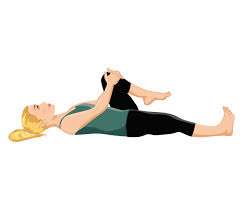
Seated Hamstring Stretch
- Sitting on a table, yoga mat, or bed, be sure your posture is correct.
- Put your heel on the floor, toes free, and point upward with the leg you want to extend straight.
- Keep your back flat, and shift your weight forward at the hips.
- Continue to flex your trunk forward until you feel a stretch in your lower leg.
- Hold this position for a short time.
- After that, return to the neutral position.
- Next, relax.
- Repeat the movement with the other leg.
- Perform this exercise 5-10 times.
Bridging
- Lie flat on your back with both legs bent and your feet resting on the floor.
- Arms should be kept by your sides, palms down.
- If head and neck support is needed, place a small pillow under it.
- Lift your back after progressively raising your pelvis.
- Make sure that your shoulders and upper body remain on the ground.
- Hold this position for a few seconds.
- Slowly move down the pelvis and back toward the ground, starting at the top of the spine.
- Until the entire back is flat against the floor once more, lower into the spine.
- Then return to your neutral position.
- Next, relax.
- Perform this exercise five to ten times.
Single Leg Bridge
- In the beginning position, lie flat on your back.
- Put your arms by your sides and extend them outward.
- Keep your feet firmly planted on the ground and bend your knees.
- Bend your knees to ninety degrees and raise your hips to the ceiling.
- Using the backs of your shoulders and your heels, hold the ground.
- Hold your hips high and raise one leg straight up into the air.
- Hold this position for a few seconds.
- Then, go back to your neutral position.
- Next, relax.
- You should complete this exercise five or ten times.
- Continue with the opposite leg.
Seated Calf Stretch
- Take a seat comfortably on the ground to begin.
- Maintain your knees in a straight line.
- You can use a resistance band to wrap the front of your foot.
- Move your foot so that it is slightly bent.
- Stay in that position with your leg flat on the ground.
- Your calf muscles are stretching, as you can feel.
- Hold on for a short while.
- Then, go back to your neutral position.
- Next, relax.
- You should complete this exercise five or ten times.
- Change your legs and repeat the exercise.
Double Knee To Chest
- Start lying down on your back with your legs extended open.
- Raise both knees to the same level, and rest your hands on the top of the leg just below the knee.
- Another place to put your hands is on the backs of your thighs.
- Slowly raise your legs to your chest.
- Hold this posture for a few seconds.
- Then, go back to your neutral position.
- Next, relax.
- Five to ten times a day, repeat these exercises.
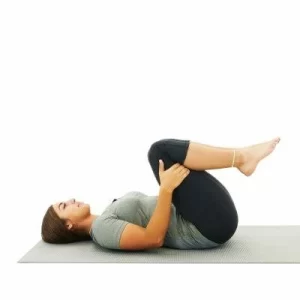
Prone leg raise
- You can use a mat or a plinth to provide some support during this workout instead of a hard floor.
- At first, you can lie on your stomach and extend your legs behind you.
- If it is uncomfortable for you, you can place your head on your arms.
- For your left leg, contract your hamstring and gluteus muscles, then raise your leg as high as you can without experiencing pain.
- Make sure that the physical therapist has stabilized your pelvic bones before beginning this exercise.
- Hold this position for a few seconds.
- Return to a neutral position after that.
- After that, relax.
- Five to ten times a day, repeat these exercises
- Perform the same movement to the other leg.
Hip Flexor Stretch
- First, bend both knees.
- At this stage, step forward one foot and bend your knee to a 90-degree angle.
- For support, if needed, you might place your hands on the front knee or keep them by your side.
- Maintaining the upper body upright.
- After that, bend forward until you feel a stretch.
- Hold this position for a few seconds.
- Step back to a neutral position after that.
- Next, relax.
- Five or ten times, repeat this exercise.
- Repeat with the other leg.
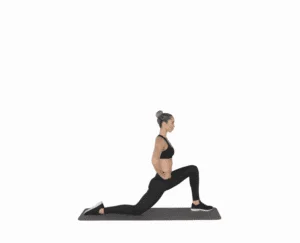
Standing Quadriceps Stretch
- Standing in the starting position.
- Raise your left arm directly in front of your body or keep it by your side. This helps in maintaining balance.
- If the patient finds this exercise difficult, they can adjust it by holding onto the back of a chair or wall.
- Bend to your left knee while holding onto your left ankle.
- Move the left foot behind the body.
- Try to pull the leg up and back by placing your hand on the ankle.
- Make sure your entire body is positioned correctly.
- For a short time, maintain this posture for yourself.
- After that, return to a neutral posture.
- Next, relax.
- Do this five to ten times.
- Use the other leg to complete the same exercise.
Hamstring wall stretch
- Your healthy leg should be against the wall when you lie on your back at the entrance.
- Place your injured leg up against the wall to straighten your knee.
- You should feel the back of your leg stretching slightly.
- Make sure your back is straight.
- Don’t flex your knees in any way.
- As you proceed, place one heel against a wall and the other on the floor.
- Right now, avoid pointing your toes.
- Please hold this posture for a time.
- Then, go back to your neutral position.
- After that, relax.
- Do this five to ten times.
- Repeat the exercise on the opposite leg.
Hamstring Stretch in supine
- Bend both of your knees and place them on the floor.
- Raise one leg over the floor and raise it to your chest.
- Hold your hands slightly below your knee, behind your leg.
- Once you have straightened your leg out, carefully raise it to your head until you feel a stretch.
- If you have trouble gripping your hands behind your leg, you can loop towels over your thigh.
- Bring your leg in toward you while holding it with your hand.
- After a little time, release the grip.
- Next, take a step back and return to the neutral position.
- Then relax.
- Do this five to ten times.
- Repeat the exercise on the opposite leg.
Iliotibial Band Stretch
- Take a sideways lying position.
- Stretching the side that is on top works best.
- Maintain a bent lower leg for stability.
- Bend your knee and reach back to grasp the ankle of your upper leg.
- The front of your thigh should feel pulled.
- Keeping your knee bent, gently place your lower leg’s foot on top of your higher knee.
- Put your foot on your upper knee and slowly drop it toward the floor. (The iliotibial band should feel like it is pulling on the side of your kneecap where it crosses the knee joint.)
- For a short time, maintain this posture for yourself.
- Return to your neutral position after that.
- Next, relax.
- Repeat the exercise on the other leg.
- You should perform this workout five or ten times.
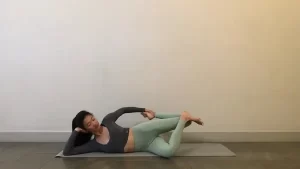
Figure Four stretch
- Lay down on your mat.
- Lie upright with your hands by your sides, knees bent, and feet flat.
- Raise your right leg and cross it over your left knee, bending your knee slightly while you rest your foot there.
- Grasp both hands behind your left knee and reach that leg toward your body while keeping your feet flexible and your head and shoulder relaxed on the mat.
- Your right knee should start to stretch.
- Hold this posture for a few seconds.
- After that, return to a neutral position.
- Then relax.
- Do this exercise five or 10 times.
- On the other leg, perform the exercise again.
Butterfly stretch
- Sitting is the starting position.
- Maintain your head and torso raised while sitting on the ground.
- Create a triangle with the soles of your feet to form your legs.
- As far as the person being treated is able, bend at the knees to the sides.
- For a more deep stretch, patients can also press down with their arms on their knees.
- keeping the patient’s head and torso as straight as possible.
- The inner thighs of the patients are stretched.
- Hold it for a short while.
- Step back into your neutral position slowly after that.
- Then relax.
- Repeat this exercise five or ten times.
Straight Leg Raise
- Start by resting down on the floor or a table in a comfortable position.
- Now slightly bend your knee.
- Then raise your leg gradually.
- Keeping a straight knee on the opposite side.
- Hold this position for a few seconds.
- Next, lower your leg.
- Return slowly to your neutral posture.
- After that, relax.
- Repeat on the opposite side.
- Five to ten repetitions for each side.
Side-lying leg raise
- On the floor or a yoga mat, rest on your right side to sleep.
- With your feet placed on top of one other and your legs lifted, your body should be in an upright posture.
- Alternatively, place your arm straight on the ground under your head or hold it with your elbow bent to support yourself.
- For extra support, place your left hand on your hip or leg or extend it out in front of you.
- Lift your left leg off the floor.
- Stop lifting your leg as soon as you feel the muscles flex.
- Pull the leg down till it touches the right leg once again after taking a few deep breaths.
- Return to your neutral position after that.
- Next, relax.
- Repeat the exercise on the other leg.
- Repeat this exercise five or ten times.
Heel Slide
- When you sleep on your back, keep your legs straight.
- Bend the knee and gently slide one heel back toward the buttock.
- Next, slowly flex your heel in the opposite direction until your leg is straight.
- Return to your neutral position after that.
- Then relax.
- Proceed with the opposite leg.
- Five to ten times a day, perform these exercises.
Plank
- Arrange yourself on the ground like you were ready to perform a push-up.
- You can change your pose by doing a plank from your knees or by supporting yourself with your bent forearms rather than your hands.
- Hold this position for a few seconds.
- Then, go back to your neutral position.
- Next, relax.
- Do this five to ten times.
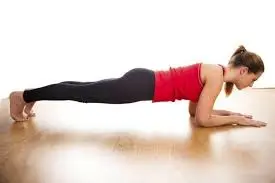
Reverse Lunge
- Step out with your feet shoulder-width apart.
- Squeeze your shoulder blades and glutes while maintaining a neutral look at a place directly in front of you.
- You can perform lunges using only your body weight or with a variety of equipment, like barbells, dumbbells, or kettlebells used in different combinations.
- Place your foot on your toe first and take a step back and slightly out.
- Try to keep your knee from touching the floor too hard.
- Bend your knees such that they make right angles with both of your legs while maintaining an upright chest.
- Step forward with your back leg to take the starting position after pushing off the ground with your front foot.
- To stay balanced and keep your body securely straight contract your core.
- Hold this position for a few seconds.
- Then, go back to your neutral position.
- Next, relax.
- Do this five to ten times.
- Repeat this exercise with the other leg.
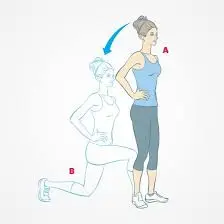
Donkey kick
- Lay down on the ground and fold your hands over your head.
- Your knees should be under your hips and your hands should be closest to your shoulders.
- You can strengthen your back and pelvis by contracting your abdominal muscles.
- Put your chin slightly down and look down and out to keep a flat back of the neck.
- To engage your glutes, flex your right foot and keep your right leg at a 90-degree bend.
- Then, raise your right leg up and behind you toward the ceiling.
- Make sure your body height is just above the point where your hips move or bend and your lower back curves, which indicates that you may have lifted it too high.
- Keep your hips parallel to the floor while keeping an upright, neutral back.
- To complete the exercise with a full range of motion and the right technique, try not to rush your movements.
- Start with lowering your right leg and then raising it back up.
- Then, go back to your neutral position.
- Next, relax.
- Proceed to the left side after completing all of the repetitions on the right side.
- Repeat this workout five or ten times.
Side lunges
- Step wide with your left leg out to the side.
- Your feet should be flat on the ground, and both of your toes should point in the same direction.
- As you take a step out, bend your left knee, and maintain your back posture.
- It must feel like you’re attempting to sit on a chair with only one side of your lower body supported.
- Push off with your left foot to release the position and go back to the beginning position.
- Start with your left leg and work your way up to your right leg in one round of side lunges.
- Then, go back to your neutral position.
- Next, relax.
- Repeat this workout five or ten times.
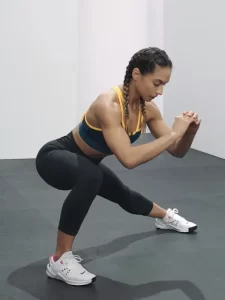
Seated knee extension
- You will need two chairs to complete this workout.
- Arrange two chairs facing one other, across from one another.
- Place one foot on the chair across from you while bending your knee.
- As much as you can, gently straighten the leg before it starts to hurt too much.
- For a short time, maintain this posture for yourself.
- Return to your neutral position after that.
- Next, relax.
- Repeat this workout five or ten times.
- Repeat this exercise with the other leg.
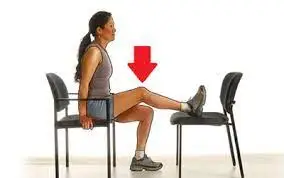
Leg cross
- Keep your ankles crossed while you sit on the edge of a chair, table, or bed.
- Your thigh muscles should become tight as you push your front leg backward and your back leg forward against one another.
- Take a moment to hold this.
- Return to your neutral position after that.
- Next, relax.
- Repeat this workout five or ten times.
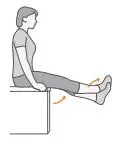
Prone Quadricep Stretch
- Lay with your face down.
- To provide support, put your right forearm in front.
- Bend the left knee and place your left hand on your shin or ankle.
- Raise the knee slowly until you feel a small, noticeable stretch.
- Hold on for a short while.
- Then, go back to your neutral position.
- Next, relax.
- You should perform this workout five or ten times.
- Use the other leg to repeat this exercise.
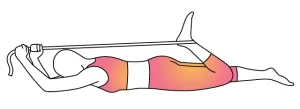
Marching glute bridges
- Lying on your back, put your feet hip-width apart and bend your knees.
- Arms at your sides should be relaxed.
- Pull your belly button inside toward your spine.
- Gradually lift your hips, lower back, and mid-back off the floor.
- As though you were starting to march, press down through your feet and raise your right foot off the ground.
- After putting your right foot back on the ground, raise your left foot.
- To make sure they’re keeping still, you can put your hands on your hips.
- Then, go back to your neutral position.
- Next, relax.
- You should perform this workout five or ten times.
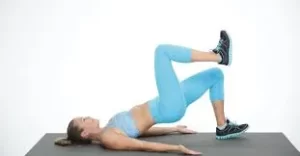
One-leg dip
- Place a stable chair with a high back next to each side of the body so that the backs of the chairs are near the arms.
- Place your hand on the back of each chair to help with balance.
- Lift your right leg to a few inches above the floor.
- The left leg should support the entire weight.
- Move your weight to the heel of the supporting leg as you downturn.
- Maintain for a few seconds.
- Gradually straighten up.
- Then, go back to your neutral position.
- Next, relax.
- You should perform this workout five or ten times.
- Use the other leg to repeat this exercise.
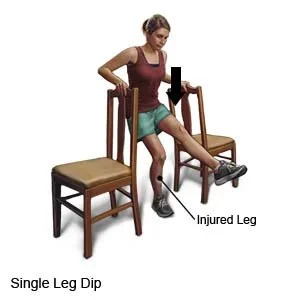
Leg slides (abduction/adduction)
- Begin by lying down on the floor and resting.
- Extend your leg out to the side while maintaining an upward kneecap position.
- Reposition yourself to the beginning position by sliding your leg back.
- After that, return to your neutral position.
- Next, relax.
- Continue to the opposite side.
- Repeat exercise 5- 10 times.
- Repeat the exercise opposite side.
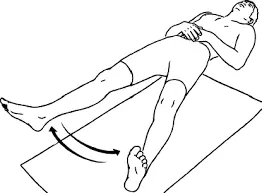
Prone knee bend
- Lie down in a comfortable prone position on the bed or table.
- Now, slowly bend your knee into a comfortable position.
- For a short while, hold it.
- Then, gradually return your leg to its neutral position.
- Then relax.
- Proceed to the other side.
- Repeat this exercise five or ten times.
Sitting ball squeeze
- Start by sitting straight at the edge of a chair with your feet flat on the floor.
- Between your knees, put a ball or cushion.
- Gently squeeze your thighs together, pressing the cushion or ball together as well.
- A few seconds of holding later, release the ball without letting it fall.
- Then, go back to your neutral position.
- Then relax.
- Repeat this exercise 5-10 times.
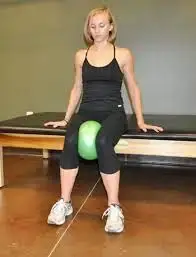
Single leg Deadlift
- You must stand with both feet under your hips to do this workout.
- Shift your weight to your left leg, which should be straight and slightly bent at the knee.
- With your leg straight, begin to drive your right foot back like you are kicking the bottom of your foot on the wall behind you.
- At the same time, begin bending forward at the waist and bending your trunk forward until it is nearly parallel to the floor.
- At all times, your arms should be straight, shoulder-height, and parallel to the floor.
- Your body should form a straight line from the top of your head to the bottom of your right foot when you are in the lowest position.
- After that, pull your right leg forward while keeping your body in a straight position and lift your body till you are upright once more. That represents a single repetition.
- Then, gradually return your leg to its neutral position.
- Then relax.
- Repeat to the other side.
- Perform five to ten repetitions on each side.
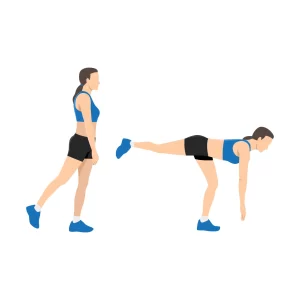
Quadriceps foam roller
- Lying on your stomach, place the foam roller under your upper legs.
- Put your arms on the floor in front of you to support your upper body, and keep your toes on the ground to support your bottom body.
- Roll up and down the upper leg between the hip and the knee, applying just enough pressure to feel the benefits of the roller.
- Increase the amount of time you spend working on any painful or tight regions.
- After that, slowly bring your leg back to neutral.
- Next, relax.
- Perform five to ten repetitions on each side.
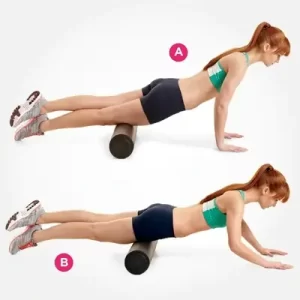
Standing Hip Extension
- Make sure you have your hands on a table or counter for stability.
- Maintaining a straight knee, extend one leg straight backward toward the ceiling.
- Keep your body in this position and focus on contracting your butt muscles.
- After releasing your leg, go back to where you were.
- Then relax.
- Repeat the exercise opposite side.
- Repeat this exercise five or ten times.
Safety Precautions for Exercise:
- If you have any pain during exercising, stop.
- If you have knee problems, stay away from box jumps.
- Avoid taking steps that cause your knees pain or feel uncomfortable.
- When exercising, avoid making sudden movements with your knees.
- Stretch, hold, and repeat the exercise correctly.
- When exercising, dress loosely to allow your body to move freely.
- Stretch the stiff muscles if they feel difficult, but you shouldn’t ever experience intense or stabbing pain.
- It’s okay to stretch the tight muscle even if it hurts. But there shouldn’t be any sharp or stabbing pain during the stretch.
- Every exercise should be performed in line with protocol, which calls for stretches before, holds between, and the right amount of repetitions for each exercise.
- Breathing should never be held during exercise. You should inhale deeply and exhale slowly when exercising. Breathing in deeply causes your muscles to tense up, raising your blood pressure.
When did you stop doing your knee exercises?
- If your physician recommended that you relax for a few days.
- if you recently suffered a fracture to your leg bone.
- Seek medical advice if you suddenly experience knee pain while exercising.
- If you have any soreness in your knees while exercising, stop.
- If you have groin pain, stay off the stairs and don’t step.
- Avoid jerky knee movements.
Good recommendations:
- Try including your workouts in your daily schedule.
- It’s not necessary to finish every exercise in a single session.
- It’s not necessary to perform the entire exercise movement on your first try.
- If a particular movement causes you pain, use this to evaluate your progress each week.
- Staying in shape can be achieved by engaging in other enjoyable activities, such as general exercise, which can significantly aid in your recovery.
- Try supporting your knee with a pillow if you have trouble sleeping.·
- Put on reasonable, properly fitting shoes, like running shoes.
- Keep moving forward. For your knee muscles to stay healthy, you must exercise them.
Lifestyle Modifications to Reduce Knee Pain:
In addition to providing immediate relief, a few easy but effective lifestyle changes can help the pain from coming again.
The following recommended lifestyle changes may provide relief from knee pain:
- Maintaining correct posture during the day, especially when sitting. Sitting with your legs crossed for extended periods is not recommended.
- To maintain the proper body weight, follow a healthy, balanced diet and exercise regularly.
- Get up and take a walk, or try to walk a little bit more each day.
- A comfortable sleeping position is required to encourage lower back and knee relaxation.
Exercising With Knee Pain: What to Avoid
- Don’t take too much time off
According to common belief, prolonged resting for painful knees might worsen knee joint pain and weaken leg muscles.
- Stay away from running
Running is a high-impact workout that puts stress on every joint in the body, particularly the knees. This is true whether you choose to run on treadmills, untouched countryside, or built routes as well. Avoid high-impact activities if you suffer from active knee pain.
- Don’t bend your knees too much
For those with knee problems, exercises like lunges and squats can be very uncomfortable. Exercise has many wonderful benefits for knee health, but these kinds of activities might aggravate already sore knees. As a result, people might shy away from exercising.
- Avoid exercising when you are in severe pain
After a hard workout or during it, aches and pains in the muscles are common. However, sudden, intense, or shooting knee pain is a sign that you need to stop the offending action right away.
When to See a Doctor if You Have Knee Pain:
There are times when visiting a doctor might be advisable, given that the majority of knee pain cases can be resolved by stretching the muscles and performing strengthening exercises. You should be concerned, for example, if you suddenly experience severe knee pain and haven’t engaged in any tough exercise recently. Getting medical attention is also necessary if knee pain limits your range of motion or makes it difficult for you to bear weight on your leg.
Also, “consulting with a doctor would be required if conservative measures such as applying cold or taking painkillers or anti-inflammatories aren’t acting as intended.” Additionally, symptoms like knee buckling or clicking or popping in the knee should be investigated.
You can maintain the health and pain-free condition of your knees by performing regular stretching and strength training of any kind. Inflammation in the body, which can lead to pain and discomfort in the muscles, can be avoided by maintaining hydration and eating a nutritious diet. Consider setting an alarm to get up and move around every hour if you spend a lot of time sitting down.
Summary
The muscles that support your knee joint can be strengthened with low-impact activities and gentle stretching. While it may seem strange, exercising compared to immobilizing an injured or arthritic knee can be beneficial to your knee. If you don’t move your knee and it becomes more rigid the pain could get worse.
It is recommended that individuals with joint pain consult a physician or physical therapist before beginning an exercise program. These professionals can provide recommendations for exercises and modifications based on your specific pain and its underlying cause. Having strong, flexible muscles and joints that can endure strain and injury is the best way to prevent injuries. Certain exercises may be able to help relieve some pain experiences in some simple knee cases. Never exercise in a way that makes your pain worse, remember.
Stretching and strengthening exercises that focus on the muscles that support your knees may help relax pain, improve range of motion and flexibility, and lower the risk of future injuries. When exercising, particularly at first, you should be careful of how painful it is for you. These workouts might increase your symptoms a little bit at first. However, with more experience, they should get easier and help with improving knee mobility.
FAQ:
How can knee pain be avoided?
Lifestyle, natural cures, protection, and relaxation. Take a break from your routine to help your knee heal from overuse, give the meniscus and surrounding ligaments time to heal, and prevent further damage to these important tissues.
Why is knee pain happening?
Age and degenerative changes are two of the many typical causes. due to any kind of knee injury, including a torn cartilage or a tear in a ligament. Certain medical diseases, such as gout, degeneration, and infections, might worsen knee pain and create swelling as well. Braces or orthoses for the knees as well as physical therapy can aid in pain relief.
Which three knee injuries are common?
The most frequent injuries to the knee include dislocations, fractures of the patella, and sprains and tears of soft tissues, which cause damage to the meniscus and knee ligament. Knee injuries frequently affect the structure of the knee. The most typical signs of a knee injury include pain, swelling, difficulty, and limited range of motion.
Does exercising prevent knee pain?
Avoid any high-impact exercises like kickboxing, jogging, and jumping as these can worsen knee pain. Also, avoid workouts that put a lot of strain on your knees, like lunges and squats. These can worsen pain and, if done improperly, result in harm and pain.
Is there a home therapy for knee pain?
Some of the best homemade treatments for knee pain at home include rest and physical activity to help the condition. Better posture and lifestyle management are also included in this.
Which type of knee pain is dangerous?
If you are incapable of putting any weight on your knee, get in touch with the doctor who treated you. You feel pain so much, even if you are not carrying any weight. You feel your knee click, collapse, and lock.
When does knee pain usually happen?
While it can affect anyone at any age, persons over 50 are the most likely to have it. You might experience pain and stiffness in your knee if you have osteoarthritis of the knee. One knee or both could be affected.
Do exercises strengthen the knees?
Exercises targeted to strengthen the knee do not immediately affect the knee joint. However, they can strengthen the surrounding muscles. Legs with strong muscles may help in supporting the knees. This could reduce tension and pressure on the joints, allowing for pain relief and increased activity levels.
Is it better to bend or keep my knee straight?
Reduce the amount of time you spend bending or crossing your knees to help your knees. When possible, try to get them straight. Try to avoid sitting with your knees crossed or bent for longer than twenty minutes at a time. Then get up and go for a walk.
What causes pain in the knee to begin?
A frequent issue that affects people of all ages is knee pain. Your knee pain might be caused by an injury such as a ruptured ligament or torn cartilage. Knee pain can also result from medical disorders such as infections, gout, and arthritis. Self-care methods work well for many types of mild knee pain.
When I have knee pain, how should I sleep?
When you have hip or knee pain, lying on your back with a pillow under your knees is the ideal sleeping position. To help straighten your spine as you sleep, consider placing a neck cushion or rolled-up towel beneath your neck. If you wish to sleep on your side, make sure you do it without causing any joint harm.
How can knee pain be recovered from the most quickly?
Relax: To reduce repetitive strain on your knee, allow the injury time to heal, and help prevent future damage, take a break from your regular activities.
Ice: Using ice can help relieve pain and swelling.
Compression:
Elevation:
Does applying ice to your knees every day help?
Application of ice is recommended multiple times a day, for a minimum of 20 minutes at a time. After cooling your knee, stop right away and see an orthopedic physician if the pain becomes more intense.
How frequently should you work out to relieve knee pain?
The frequency of the strength training should be limited to every other day, and if the knee pains after a session, the intervals between sessions should be longer. After every workout, keep performing the step-up movement.
What are the goals of knee exercises?
Strengthening activities create strength to support your knee, but they can also cause muscle tightness. Injuries are more likely to happen in tight muscles. After engaging in a strengthening exercise, gentle stretching helps to reduce pain and maintain your muscles’ length and flexibility.
Which exercises help with knee pain relief?
Choose low-impact workouts that focus on your quadriceps and hamstrings, which are the muscles that surround your knee joint. This may relieve tension and support the knee joint.
Which workouts improve knee strength?
Leg extensions
Lunges.
Calf raises
Straight leg raise
Hamstring curls
Step-ups
Squats
How Knee Pain Can Be Helped by Stretching?
Stretching can improve strength and flexibility, which could help in dealing with muscle imbalances resulting in knee pain. For example, Running may limit your range of motion, making it more difficult for you to use your entire range of motion. This could cause overuse of certain muscles in runners.
How can I instantly get rid of my knee pain?
If you have knee pain while you sleep, place a cushion between your knees. Take a warm bath, apply heat or ice to the knee, and massage it for additional pain relief. The ideal time to be active is during the day. Regular exercise and stretching can help manage knee pain and improve sleep at night.
Is walking the most effective treatment for knee pain?
There are many advantages to walking as exercise, especially for senior citizens. It relieves the strain on the joints and promotes cardiac health, circulation, and balance. Also, walking may help prevent and lessen knee pain associated with osteoarthritis, the most prevalent kind of arthritis
Can a knee be fixed without surgery?
Rehabilitation medicine and exercise routines can help to strengthen and stretch the soft tissues and muscles in your knee joint, resulting in increased flexibility and joint support. By keeping your knee from becoming overly pressured, altering your daily routine can also as help reduce knee pain.
Can knees recover completely?
The time it takes for a knee injury to heal can vary based on different factors. It can take two weeks to nine months for common knee injuries to heal completely. A little cut may not require major medical treatment. For some injuries, physical therapy, surgery, and a long time to recover may be necessary.
Does cycling help with knee pain?
Cycling is a low-impact exercise that is more gentle on the joints than sports like running or jumping. It is also a fantastic choice for those who have knee pain. The muscles surrounding the knee are strengthened by cycling, which can support the joint and reduce pain.
References:
- Ladva, V. March 8, 2023. Knee exercises and electrotherapy techniques are used in physical therapy for knee discomfort. Samarpan Clinic for Physiotherapy. https://samarpanphysioclinic.com/knee-pain-physiotherapy/
Reference within the text: Ladva, 2023 - A. N. P. D. C. Sfma (n.d.). The PT Hospital for Special Surgery offers stretches and exercises for treating knee pain. Writing the article “Stretches and Exercises for Knee Pain”
Reference inside text: (Sfma, n.d.) - Exercises for issues with the knee’s muscles and joints NHS inform. Dec. 1, 2023. Exercises for Knee Problems: https://www.nhsinform.scot/illnesses-and-conditions/muscle-bone-and-joints/
Reference within the text: (Knee Muscle and Joint Problem Exercises | NHS Inform, 2023) - OrthoInfo – AAOS Knee Conditioning Program (n.d.). The Knee Conditioning Program https://orthoinfo.aaos.org/en/recovery
In-text Citation: (OrthoInfo – AAOS, Knee Conditioning Program, n.d.) - Lindberg, S. (2024, January 31). 10 Exercises to Relieve Knee Pain. Healthline. https://www.healthline.com/health/exercises-for-knee-pain In-text citation: Lindberg (2024).
- C. (15 May 2023). The Goods and Bads of Working Out When Knee Pained. The Orthopedic and Spine Center. What to do and what not to do when exercising when experiencing knee pain In-text Reference: (2023)
- Image 1, W. (June 5, 2018). Three Ideas to Stay Warm on Your Feet This Winter. Leg & Foot Center. Three tips to keep your feet warm this winter: https://www.footandleg.com.au In-text Reference: (2018)
- Image 2, Exercises for the Vastus Medialis: Building and Extending the VMO. (n.d.). Over at Knee-Pain-Explained.com. This page provides exercises for the vastus medialis. In-text Citation: (Exercises for the Vastus Medialis: Building and Expanding the VMO, n.d.)
- Image 3, calf stretches to treat severe illness. (As of now). The following product link: https://www.triceas.top/products.aspx?cname=calf+stretches+for+sever%27s+disease&cid=6 Reference within the text: “Calf Stretches for Sever’s Disease,” n.d.
- Image 4, Time to work out: half a squat. (As of now). https://www.healthhub.sg/live-healthy/half-squat-exercise-time Reference inside text: Time-to-exercise-half-squat (n.d.)
- Image 5, Workouts, routines, and exercises related to chair-assisted calf raises. (As of now). Chair-assisted Calf Raises: https://www.workoutsprograms.com/exercises (Workouts, Routines, and Chair-Assisted Calf Raise Exercises – Exercises, n.d.) is cited inside the text.
Image 6, W. (November 24, 2011). Exercise for the hamstrings: single-leg curls or standing curls. YouTube. sMuh-Z4_PI8 can be seen on YouTube.
Reference inside text: (2011) - Image 7, Online store 16717428 (n.d.). The product details page for this item is 16717428. html.
Reference within the text: (16717428 – Online Store, n.d.) - Image 8, D. (June 11, 2021). Exercise Guide with Illustrations for Lying Hamstring Curls. The SPOTEBI website provides a workout guide using lying hamstring curls.
In-text Reference: (2021) - Image 9, Pickover, E. July 26, 2023. According to a study, wall squat exercises can help decrease blood pressure. The Independent. Hiit-Kent-B2382041.html, https://www.independent.co.uk/life-style/health-and-families
Citation inside the text: Pickover (2023) - Image 10, D. (11 June 2021). Step Up With Knee Raise | Visual Exercise Guide. Climb with a raised knee using SPOTEBI. Exercise Guide: https://www.spotebi.com/ In-text Citation: (2021)
- Image 11, Strengthening: Standing Knee Flexion. (n.d.). This link will take you to a page where you can download the Exkit for Orthopedics in English (0290000628knhp024m_English.html).
Internal Reference: (Fortifying: Bending the Knee (Standing), n.d.) - Image 12, Extended Hand to Toe Pose: Utthita Hasta Padangusthasana | Gaia (n.d.). Earth. The extended hand-toe pose is a variation of the Padangusthasana pose. In-text Citation: (Extended Hand to Toe Pose | Gaia, n.d.) Utthita Hasta Padangusthasana
- Image 13, Upavistha Konasana. (December 25, 2020). The Collective Yoga. The wide-angle seated forward bend upavistha konasana is one of the poses offered by The Yoga Collective. Reference within the text: Upavistha Konasana (2020)
- Image 14, C. (February 17, 2014). Flex your quadriceps muscles by lying on your side. Quadriceps stretch side lying down, G4 Physio. https://www.g4physio.co.uk/blog/common-stretches-advice
The 2014 In-Text Citation - Image 15, Online store 118202292 (n.d.). Paniceyesm.life/product_details/118202292.html for the product Reference within the text: (118202292 – Online Store, n.d.)
- Image 16, B. (November 14, 2017). Pinterest. https://in.pinterest.com/pin/462111611756691726/ Resistance Band Training
In-text Reference: (2017) - Image 18, S. on January 7, 2022. How Are Quadriceps Sets (Quad Sets) Performed? Staying in shape with a and – Medium. Medium. This is how to perform quadriceps exercises: https://medium.com/stayfitwithanand/quad-sets-c582e33177d9.
In-text Reference: (2022) - Image 19, A. December 24, 2021. Steps, Advantages, and Contraindications for Paschimottanasana; 101yogasan. https://101yogasan.com/diarrhea/paschimottanasana.htm In-text Reference: (2021)
- Image 39, Schultz, R. (November 2, 2021). How to Perform Reverse Lunges Correctly. The Health of Women. Reverse lunges: https://www.womenshealthmag.com/fitness/a25440343/
Reference within the text: Schultz, 2021 - Image 41, The Ideal Lateral Lunge Is Good Form. (As of now). Nike.com. The ideal lateral lunge: https://www.nike.com/in/a
Internal Reference: (Nice Form: The Ideal Lateral Lunge, n.d.) - Image 42, To view, sign up, or log in. (As of now). hakeemsulemankhan on Facebook: /photos/a.136184566456907/991152604293428.jpg In-Text Reference: (Sign up or log in to View, n.d.)
- Image 43, D. M. Brooks (2005) Aug. arthritis-related exercises. Gerontological Nursing Journal, 31(8), 3–4. Doi: 10.3928/0098-9134-20050801-04
Reference within the text: Brooks, 2005 - Image 44, Seven quad stretches that help you decompress – Sepcleat [undated]. Quad stretches are a great way to loosen up your legs. According to Sepcleat, here are seven ways to do so. In-text Citation: (Sepcleat, n.d.) Quad Stretches: 7 Ways to Loosen Up Your Legs
- Image 45, S. Trainor (2015) 28 March. RS Fitness, GLUTE Bridge March. RS Exercise Instruction. March is a tip from https://rsfitnessla.com.
Reference within the text: Trainor (2015) - Image 46, Iliotibial Band Syndrome Exercises – What You Need to Know. (As of now). Drugs.com. Exercises for Iliotibial Band Syndrome: https://www.drugs.com/cg.html
Internal Reference: (Exercises for Ilitibial Band Syndrome: Everything You Need to Know, n.d.) - Image 47, Complete Citation: Extended Knee (Supine) Hip Abduction / Adduction. (n.d.). https://iris.hattiesburgclinic.com/patadv/exkit/Orthopedic/English/0290000680knhp050m_English.html is not available at this time.
Reference within the text: (Hip Abduction / Adduction: With Extended Knee (Supine), n.d.) - Image 48, (n.d.). Rehabilitation.
Ligamento Medial Collateral. McLtearpoppy’s rehabilitation page on Weebly
Reference within the text: (Rehabilitation, n.d.) - Image 49, Seated ball squeeze (n.d.). Ball squeeze seated exercise: https://www.spineandsportspt.org/exercises/
Reference within the text: Ball Squeeze-Sat, n.d. - Image 50, Putra, L. ( February 28, 2023). Download the image of a woman performing a single-leg deadlift. Vector art that is isolated and placed on a white background. https://www.vecteezy.com/vector-art/20537700-flat-vector-illustration-of-a-woman-doing-a-one-leg-or-single-leg deadlift exercise against a white background Citation within the text: (Putra, 2023)
- Image 51, Yoong, F. April 10, 2023. The Top 5 Foam Roller Exercises to Alleviate Tension and Pain in Your Muscles – Your Physical Therapist. Your Physical Therapist. The top five foam roller exercises to relieve tension and pain in your muscles are listed here.
Citation inside the text: Yoong (2023)

